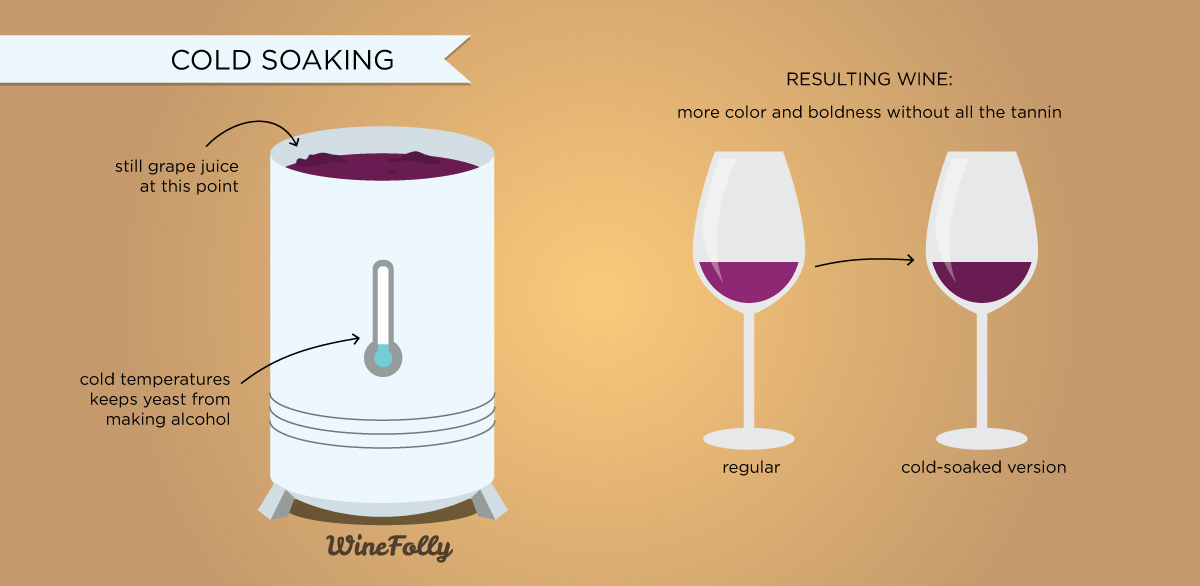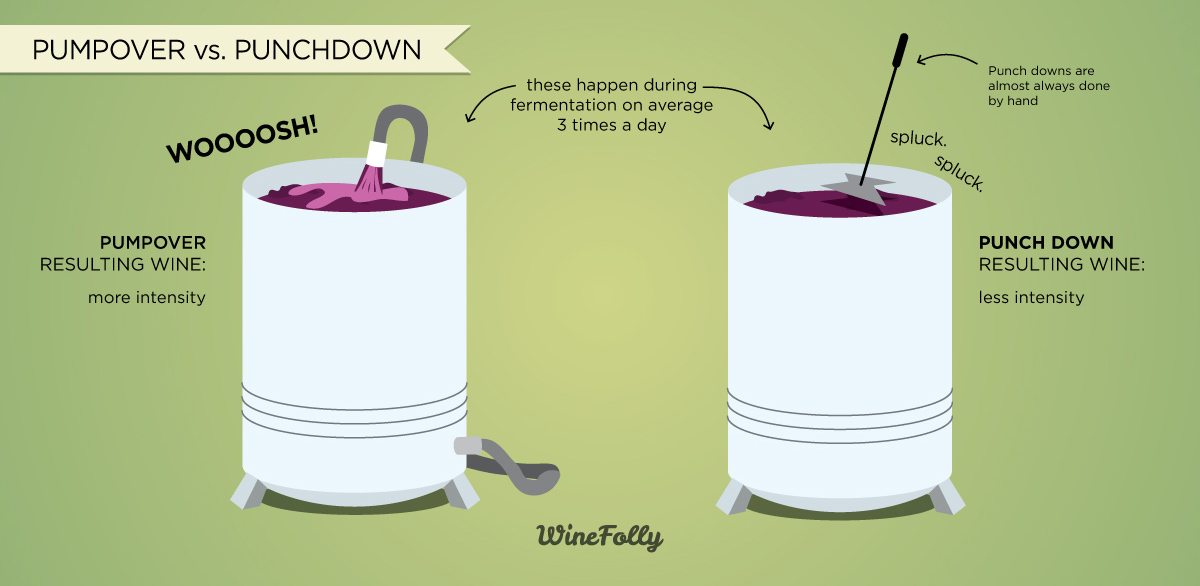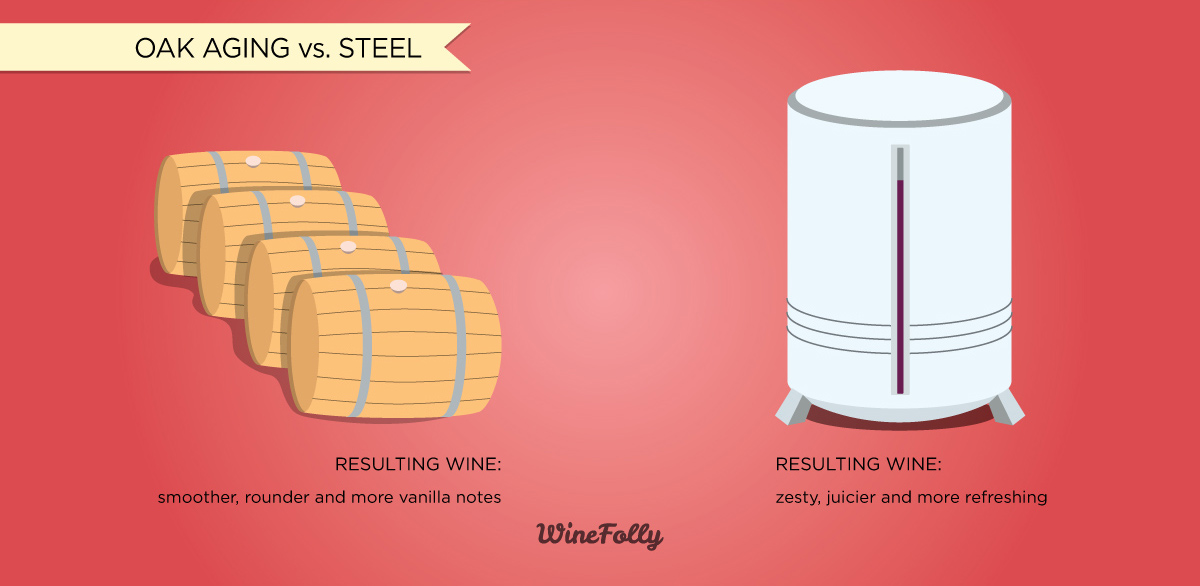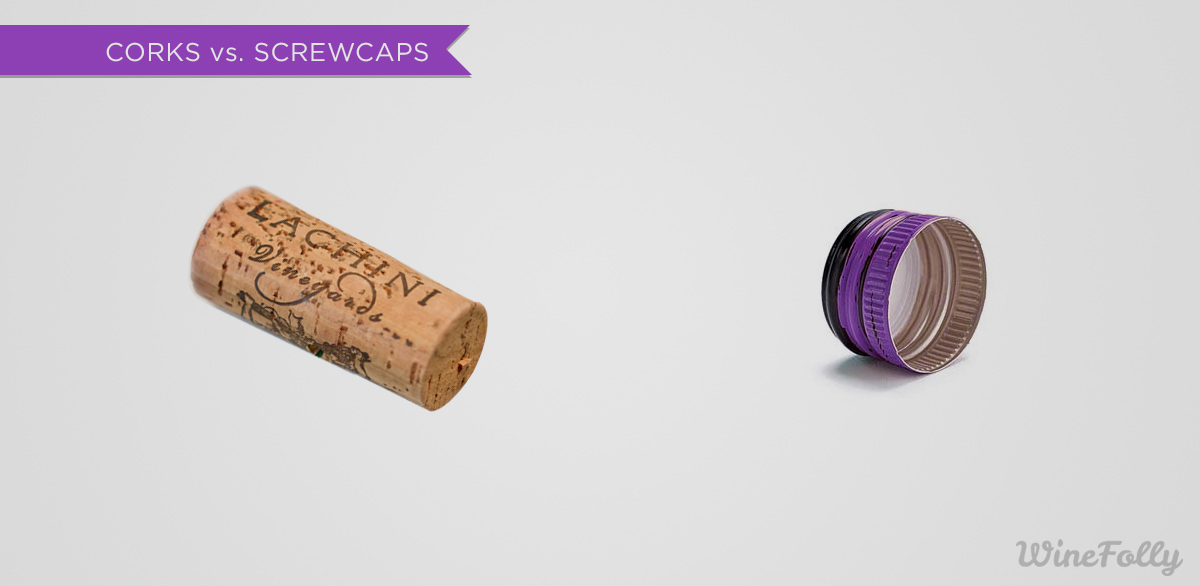You may come across these terms the next time you visit a winery. By knowing about them, you’ll understand the winemaker’s goals and even the styles of the wines before you taste them.
We talked with a Washington red wine making specialist, Landon “Sam” Keirsey, about some of the most important wine making processes:
- Harvest date
- Maceration Time (and “Skin Contact”)
- Fermentation Temperature
- Punchdowns vs. Pumpovers
- Oak vs. Steel Tank
- Corks vs. Screwcaps
6 Winemaking Processes to Know

1. Harvest Date
The moment the grapes are picked is a big deal. Picking earlier will produce wines with higher acidity, lower alcohol, and sometimes more green or herbal flavors. It could also lend to more bitter tannin but the wines tend to age longer. Picking later in the harvest season will produce wines with lower acidity, higher alcohol (or sweetness), and riper tannin.
When picked too late some wines must be artificially acidified in order not to taste flabby. Additionally, some will have water added to them (called ‘watering back’) to reduce the alcohol concentration in the completed wine. This could be why many commercial wines have identical ABV levels of 13.5%.
Besides picking the grapes at the moment when acidity level and sweetness are perfectly in balance there’s also a weather problem. Every vintage is different. Sometimes weather takes a turn for the worse at the end of the growing season and can even result in a bad vintage.
In a situation where rains are forecasted in cooler climate areas (Northern Italy, Burgundy, Oregon, etc) some winemakers choose to hedge their bets and pick grapes before optimal ripeness.
2. Maceration Times, Cold Soaking, and Skin Contact
Winemakers often talk about maceration time (skin contact) and cold soaking. Both of these terms refer to how long the grape skins touch the juice while it turns into wine.
Cold soaking is a process that happens before the alcoholic fermentation. By keeping the grapes cold, the grape must is too cold for yeast. This allows color and fruit flavors to extract from the skins without extracting bitter tannins. The total time that grape skins touch a wine (including the fermentation) is maceration time.
For example, a Syrah producer called Kessler Haak in Sta Rita Hills, California macerates their wines for 50 days to extract the color and flavor.
In comparison a few miles east in Santa Ynez, a Syrah producer called Solminer Wine Company macerates for just 28 days. The difference in color of the two wines is remarkable: one is very opaque and rich and the latter is pale and delicate like a Pinot Noir. By the way, normal red wine fermentation generally takes around 2 weeks to complete.
You can understand the skin contact concept by testing the differences in tea flavor by varying how long it sits in hot water.

3. Hot Fermentation vs. Cool Fermentation
Fermentation temperature is another technique that changes resulting fruit flavors and color in a wine. A hot fermentation can get up to 80-100 °F (26-37 °C — nearly hot tub temperature) as the yeasts metabolize and produce alcohol. Warmer fermentations commonly work for red wines to increase color and tannin. There are also several minimalist producers practicing warmer fermentation temperatures on white wines. Their goal is non-interventionist wine making that is more in tune with the conditions of the vintage.
Cold and cooler fermentations are usually practiced on white and rosé wines. Keirsey explained that cooler temperatures (from 42 – 50 °F, 6 – 10 °C ) help preserve delicate aromas in white wines.
The reason you want a cooler fermentation is volatile aroma compounds (delicate floral aromas) won’t burn off. This is also probably why wine serving temperature greatly affects the taste of wine out of the bottle.
4. Pump Overs vs. Punch Downs
Pumpovers
Pumpovers extract higher amounts of tannin in a wine depending on the frequency and force. Some pump over systems are basically wine sprinklers, offering a gentler extraction and some aggressively stir up the fermentation tank. For larger fermentation tanks in commercial operations, much needed oxygen comes through a pump over device.
Punch Downs
Punch downs, on the other hand, are a very delicate way of stirring a wine. They keep skins from getting too extracted and little to no amount of added oxygen in the fermentation. Punch downs are typically done by hand and are more popular with non-interventionist winemaking.
5. Oak-Aging vs. Steel Tank
Oak aging does more than just add a vanilla flavor to wine. Oak increases a wine’s exposure to oxygen while it ages. Oxygen decreases tannin and can help a wine reach its optimal fruitiness. Wines aged for many years in oak develop nutty flavors.
Steel tanks are commonly used for zesty white wines like Pinot Gris, although it’s not uncommon to find steel tank aged red wines. Steel tanks limit the oxygen exposure to wine and keep wines fresher. Some red wines like Garnacha are sensitive to oxidation and work better in a steel or concrete tank.
6. Corks vs. Screwcaps
One misunderstood topic about winemaking is the choice of using a cork or a screwcap. In most circumstances there is no difference between wine in a bottle with a cork or a screwcap. When asked what he preferred, winemaker, Landon Sam Keirsey said:
Personally if it was my decision I would use screwcaps.
The interesting thing about the topic of wine closures is that corks let oxygen in at unpredictable amounts. There is also an issue with TCA “cork taint” that affects about 1-2% of wines. Screw caps (and other cork alternatives), on the other hand, can control the amount of oxygen that comes inside the bottle per year.
There are several other wine making processes not included in this article such as using sorting tables, grape crushing, whole cluster, destemming, and yeast selection. Instead of including all of the wine making processes, we asked Landon ‘Sam’ Keirsey to help us focus on some of the most important ones.



